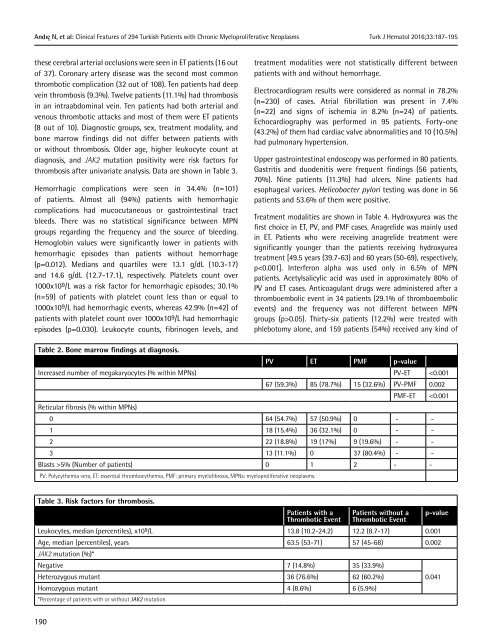Turkish Journal of Hematology Volume: 33 - Issue: 3
You also want an ePaper? Increase the reach of your titles
YUMPU automatically turns print PDFs into web optimized ePapers that Google loves.
Andıç N, et al: Clinical Features <strong>of</strong> 294 <strong>Turkish</strong> Patients with Chronic Myeloproliferative Neoplasms Turk J Hematol 2016;<strong>33</strong>:187-195<br />
these cerebral arterial occlusions were seen in ET patients (16 out<br />
<strong>of</strong> 37). Coronary artery disease was the second most common<br />
thrombotic complication (32 out <strong>of</strong> 108). Ten patients had deep<br />
vein thrombosis (9.3%). Twelve patients (11.1%) had thrombosis<br />
in an intraabdominal vein. Ten patients had both arterial and<br />
venous thrombotic attacks and most <strong>of</strong> them were ET patients<br />
(8 out <strong>of</strong> 10). Diagnostic groups, sex, treatment modality, and<br />
bone marrow findings did not differ between patients with<br />
or without thrombosis. Older age, higher leukocyte count at<br />
diagnosis, and JAK2 mutation positivity were risk factors for<br />
thrombosis after univariate analysis. Data are shown in Table 3.<br />
Hemorrhagic complications were seen in 34.4% (n=101)<br />
<strong>of</strong> patients. Almost all (94%) patients with hemorrhagic<br />
complications had mucocutaneous or gastrointestinal tract<br />
bleeds. There was no statistical significance between MPN<br />
groups regarding the frequency and the source <strong>of</strong> bleeding.<br />
Hemoglobin values were significantly lower in patients with<br />
hemorrhagic episodes than patients without hemorrhage<br />
(p=0.012). Medians and quartiles were 13.1 g/dL (10.3-17)<br />
and 14.6 g/dL (12.7-17.1), respectively. Platelets count over<br />
1000x10 9 /L was a risk factor for hemorrhagic episodes; 30.1%<br />
(n=59) <strong>of</strong> patients with platelet count less than or equal to<br />
1000x10 9 /L had hemorrhagic events, whereas 42.9% (n=42) <strong>of</strong><br />
patients with platelet count over 1000x10 9 /L had hemorrhagic<br />
episodes (p=0.030). Leukocyte counts, fibrinogen levels, and<br />
treatment modalities were not statistically different between<br />
patients with and without hemorrhage.<br />
Electrocardiogram results were considered as normal in 78.2%<br />
(n=230) <strong>of</strong> cases. Atrial fibrillation was present in 7.4%<br />
(n=22) and signs <strong>of</strong> ischemia in 8.2% (n=24) <strong>of</strong> patients.<br />
Echocardiography was performed in 95 patients. Forty-one<br />
(43.2%) <strong>of</strong> them had cardiac valve abnormalities and 10 (10.5%)<br />
had pulmonary hypertension.<br />
Upper gastrointestinal endoscopy was performed in 80 patients.<br />
Gastritis and duodenitis were frequent findings (56 patients,<br />
70%). Nine patients (11.3%) had ulcers. Nine patients had<br />
esophageal varices. Helicobacter pylori testing was done in 56<br />
patients and 53.6% <strong>of</strong> them were positive.<br />
Treatment modalities are shown in Table 4. Hydroxyurea was the<br />
first choice in ET, PV, and PMF cases. Anagrelide was mainly used<br />
in ET. Patients who were receiving anagrelide treatment were<br />
significantly younger than the patients receiving hydroxyurea<br />
treatment [49.5 years (39.7-63) and 60 years (50-69), respectively,<br />
p0.05). Thirty-six patients (12.2%) were treated with<br />
phlebotomy alone, and 159 patients (54%) received any kind <strong>of</strong><br />
Table 2. Bone marrow findings at diagnosis.<br />
PV ET PMF p-value<br />
Increased number <strong>of</strong> megakaryocytes (% within MPNs) PV-ET

















